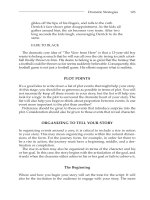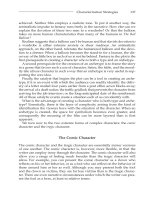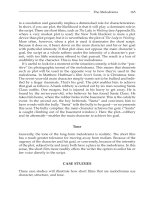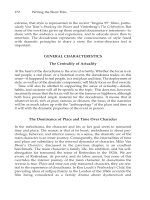Tài liệu Writing the short film 3th - Part 23 docx
Bạn đang xem bản rút gọn của tài liệu. Xem và tải ngay bản đầy đủ của tài liệu tại đây (119.01 KB, 7 trang )
audience, as does the past tense. That is not to say that a reminiscence about
the past can’t be emotional; rather, the writer should try to keep the action in
the present and in development, and that means active, present-tense dia-
logue. The more immediate the dialogue, the more emotional and the more
surprising the story will be.
Remember, when dialogue intended to develop plot is separated from
character, emotion is lost, and the dialogue becomes no more than descrip-
tive. For dialogue to be vital to the plot, it must be related to the desires of
the character as he or she moves through the plot. Dialogue is only dynamic
when it forwards the plot.
DIALOGUE AS TRANSITION
Dialogue can be very useful in providing transitions between scenes. One
of the problems the writer faces is the task of “collapsing” a story that may
take place over a long time and in a number of geographical locations into
a script less than 30 minutes long. Even the story of one day or one moment,
as in the case of Enrico’s Incident at Owl Creek, requires transitions to con-
vince us of the dramatic use of time and place in the script. Changes of time
and place occur in the original story, “An Occurrence at Owl Creek Bridge,”
making it seem to take place over a full day, whereas this 30-minute film
refers only to the last 5 minutes in the life of the main character. The writer
has to convince us of the dramatic time, creating a sense of real time by
punctuating the end of the action.
Writers can facilitate transitions by simply repeating a phrase. In Citizen
Kane, the repetition of “Merry Christmas” and “Happy New Year” allows us
to leap 20 years into the future. Of course, the time shift can be more mod-
est. Either way, the writer can use repetition to alert the viewer that one
scene or location is related to the next.
A more direct approach is simply to tell the audience in one scene where
we will be in the next. When the two climbers in our imaginary film tell us
they want to go to the peak of the mountain, we are prepared for the fol-
lowing scene on the mountainside or at the peak. The dialogue here can be
as involving as you want it to be. If this climb is but one of a series of climbs,
in a series of locations, the dialogue can alert us specifically to the next
mountain range or the next phase in this journey. Once alerted, we are pre-
pared for the transition in place or time and will go along.
Because of the dramatic collapse of real time and place in the screen
story, dialogue is very important; it provides the transitions so that we
can more readily accept and enter the time and place frames of the screen-
play. Without that preparation, we would be lost—or worse, indifferent to
the screen story.
144 Writing the Short Film
Ch12.qxd 9/27/04 6:09 PM Page 144
DIALOGUE TO INTENSIFY TENSION
Just as dialogue is the expression of the emotions of the character in terms of
arcing toward a goal, it is also the barometer of that arc as the character
moves through a scene. Perhaps the best way to understand this notion is to
consider that every scene has an arc from the point where we understand the
character’s goal to the point where the character either succeeds or fails in
achieving that goal. In either case, the scene should be shaped by a growing
anticipation of achieving the goal, or by the tension between the character
and the barrier to success. As the character tries more forcefully to achieve
the goal, the tension should grow. Once we know the fate of the character in
terms of the goal, that tension is resolved. Dialogue plays a critical role in the
articulation of that growing tension.
As with other dramatic elements, the writer should not rely solely on the dia-
logue to create that tension. Visual action, interaction between characters, as
well as the nature of the setting can and should contribute to the scene. If these
elements are well considered, they free the dialogue to be less direct and more
effective—expressing feeling in a more oblique way. Direct dialogue would be
obviously purposeful, less masked, and consequently less effective. For exam-
ple, returning to our mountain-climbing scene, we see that the scene already
has an overlay of religiosity, in terms of the devotion of one of the characters
and the irreverence of the other. The failing light introduces an element of dan-
ger. If we also introduce another factor, a twisted ankle, we develop a physical
barrier to the goal. We then have as barriers a personal tension, over religion,
between the climbers; a visual danger, the loss of light; and a physical danger,
a twisted ankle. There would be an obvious visual explanation for the danger
or tension in the scene. This is more effective (and less direct) than their speak-
ing about the danger of the climb, the time, and their health.
As you might imagine, there are any number of other external factors we
could introduce to raise the tension in the scene. But working with the fac-
tors we have named—personal differences, the loss of daylight, and an
injury—we can construct a scene that progresses through a series of stresses,
from the least stressful to the most. These factors can be elements in the dia-
logue throughout the scene, but when we want to increase the tension, we
should shift that dialogue to a factor that clearly yields more tension. For
example, references to discarding sunglasses might humorously imply con-
cern about the impending nightfall. The irony increases tension.
The most dangerous factor in the climb to the peak is the loss of day-
light. If the personal injury were to worsen, they would stop the climbing.
The personal differences are always there regardless, but the daylight,
whatever they do or say, will be running out as they progress through the
scene. Therefore, in order to increase the tension in the scene, the writer
can focus the dialogue on the loss of daylight, such as the reference to
More on Dialogue Strategies 145
Ch12.qxd 9/27/04 6:09 PM Page 145
sunglasses. By shifting the focus between the three factors, the writer can
modulate and make more effective the rising tension.
DIALOGUE TO RELIEVE TENSION
Dialogue can be used equally effectively to relieve tension. The writer must
keep in mind the arc of the tension as it builds throughout the scene. In order
to reduce tension, the writer can employ humor at strategic points. Humor
should not be as direct as a character suddenly stopping to tell a joke.
Although this approach might work, it tends to take the viewer out of the
scene. Relief of tension should keep us in the scene but simply drop the
stress level of its characters.
Humor is useful when it surprises and disarms us. As with the other dra-
matic elements, it can be derived from a visual action. More often, however,
it comes out of the reaction of a character to a visual situation. A reference to
escalators by a climber who has a physical injury and is attempting to climb
a mountain is a surprise, which helps to relieve tension for the audience.
Such a reference is an improbable wish, one that can also give voice to the
stress the character feels during the climb.
Humor can range from the aggressive to the absurd. Often writers will
have one character in a scene say the wrong thing, tell a joke, or voice a
funny complaint that relieves the tension. In this sense, character can be the
source of humor. Often that character is the most anxious one, the character
who carries feelings on his or her sleeve.
NARRATION
Narration occurs more frequently in the short film than in the longer dra-
matic form. The most obvious reason is the best one: there is too little time
available to the writer to allow the action to develop on its own. Whether to
frame the story or to establish the point of view toward the narrative events,
writers of short films often will resort to a narrator.
The narrator may be onscreen, like the grandmother in Lisa Shapiro’s
Another Story (the script is reprinted in Appendix B). Or the narrator may be
offscreen, a guide or interpreter for the story. The actual dramatic needs of
the story will determine whether the narration will be interior or exterior.
Interior Narration
Interior narration is a private monologue on the events of the story. Perhaps
it’s easiest to think of it as a confession by the narrator to the viewer. Writers
146 Writing the Short Film
Ch12.qxd 9/27/04 6:09 PM Page 146
resort to interior dialogue to foster intimacy, deepen emotion, or offer reve-
lations in the narrative. Some writers believe that a counterpoint of visual
and voice strengthens both. For example, objective visuals can be under-
mined by a subjective narrator, or the interior voice can whisper an inter-
pretation that clashes with the visuals that are cold and formal, rather than
keeping with the tone of the intimate narration.
Where an intimate, closer relationship between the character and the audi-
ence is the goal, the interior narration can act as window between viewer
and screen story.
In order to intensify a sense of inner voice, some writers will make use of
a poetic narration. Others will use the language of passion, in preference to
the language of science. The dialogue would include words such as “love,”
“want,” and “possess” rather than “respect,” “conclude,” and “contain.”
Whatever the approach, the writer chooses language that emphasizes inti-
macy, feelings, sharing, and insight.
Exterior Narration
An external or distant voice is useful when the writer wants to distance us
from, or present an alternate view to, the visual drama. Many approaches
can distance the viewer, but most often the writer will borrow from journal-
ism and use an “on-the-air” narrator or offscreen voice. The purpose is not
only to distance the viewer but also to lend an air of objectivity and credi-
bility to the proceedings.
If the drama is presented as reportage rather than fiction, the audience will
develop a different relationship with the dramatic material. This is not
always a relationship of respect; the journalistic narration can also under-
mine the credibility of the drama, or supersede it with a new reality. In either
case, the exterior narration introduces another voice into the drama. If that
voice is purposeful, it can strengthen the dramatic impact of the script.
The specific language of the exterior narration tends to be objective, jour-
nalistic, even scientific. The narration is organized to enhance credibility,
perhaps a credibility not present in the visuals. Consequently the use of past
tense, conditional verbs, and subjunctive phrases all support the distancing
goals of the exterior narration. If the writer pushes subjectivity and passion,
the credibility that is often derived from information, usually statistical or
scientific, can be undermined, or at least made suspect.
SILENCE
Now that we have discussed narration, we need to note that the visual and dra-
matic dimensions of the script may become crowded. It is worth considering
More on Dialogue Strategies 147
Ch12.qxd 9/27/04 6:09 PM Page 147
the absence of dialogue and narration, particularly where one or both have
been used in the script.
When a silence is juxtaposed with a scene filled with sound, that silence,
momentary or protracted, can be deafening in its dramatic impact. Just as
the counterpoint of visual and sound can heighten the drama, so too can a
counterpoint of sound and silence. Let’s turn back to our climbers on the
mountain. They have personal differences, one of them has a physical injury,
and as they climb they are quickly losing light. We spoke of the growing ten-
sion conveyed in the dialogue, particularly around the issue of impending
darkness. A way of using silence effectively would be to shift to silence at
that moment when darkness arrives. Suddenly there is no more dialogue,
and the characters’ sudden silence screams out their fear. Silences can be as
powerful as dialogue and narration.
DIALOGUE AND REALISM
Dialogue as sound is the most immediate device with which the writer cre-
ates a tone for the film. The writer can choose to use dialogue to convince
viewers that what they are experiencing is real, or to undermine deliberately
the film’s sense of reality. In either case, dialogue is the most immediate vehi-
cle to achieve these ends, but the writer has only a brief time to capitalize on
that first impression.
In order to deepen the impression of realism, the writer must flesh out and
capitalize on the dialogue. This means doing in-depth research and making
informed decisions as to time, place, age, gender, race, education, physical
qualities, and behavioral characteristics. Every factor about character will
and should influence what the character says. Each time the character
speaks, that sense of realism should be deepened. There is no better way to
convince an audience to believe in your characters than through what they
say. How realistic and credible your characters are will influence the audi-
ence’s response to the characters and their story. That’s how important dia-
logue is!
You have to decide what level of realism suits your story, and it is to this
issue that we now turn.
THE LEVEL OF REALISM
Many short film genres do not rely on an absolute sense of realism. Perhaps
only the mockumentary requires a sense of believability that lasts until the
very end of the story. The other genres (the fable, for example) require some
realism, but not so much that it crowds out the fantastic, the supernatural,
from the screen story.
148 Writing the Short Film
Ch12.qxd 9/27/04 6:09 PM Page 148









